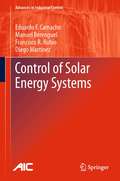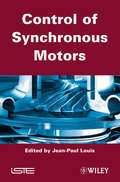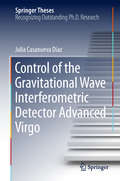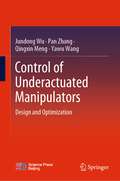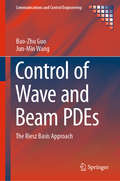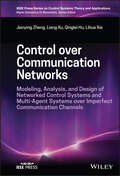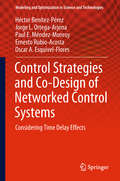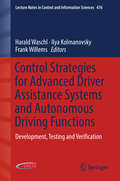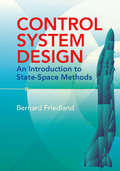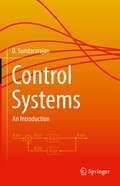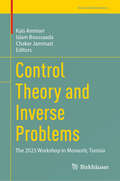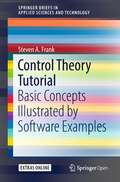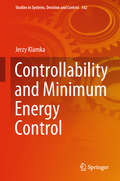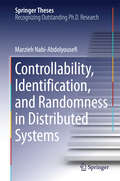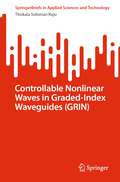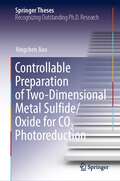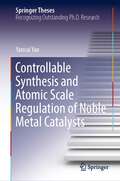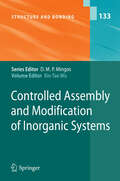- Table View
- List View
Control of Solar Energy Systems (Advances in Industrial Control)
by Manuel Berenguel Diego Martínez Eduardo F. Camacho Francisco R. RubioControl of Solar Energy Systems details the main solar energy systems, problems involved with their control, and how control systems can help in increasing their efficiency. Thermal energy systems are explored in depth, as are photovoltaic generation and other solar energy applications such as solar furnaces and solar refrigeration systems. This second and updated edition of Advanced Control of Solar Plants includes new material on: solar towers and solar tracking; heliostat calibration, characterization and offset correction; solar radiation, estimation, prediction, and computation; and integrated control of solar plants. This new edition contains worked examples in the text as well as proposed exercises and simulation models and so will be of great use to the student and academic, as well as the industrial practitioner.
Control of Surge in Centrifugal Compressors by Active Magnetic Bearings: Theory and Implementation (Advances in Industrial Control)
by Paul E. Allaire Zongli Lin Se Young YoonSurge Control of Active-magnetic-bearing-suspended Centrifugal Compressors sets out the fundamentals of integrating active magnetic bearing (AMB) rotor suspension technology in compressor systems, and describes how this relatively new bearing technology can be employed in active control of compressor surge initiation. The authors provide a self-contained and comprehensive review of rotordynamics and the fundamentals of AMB technology. The active stabilization of compressor surge employing AMBs in a machine is fully explored, from modeling of instability and controller design, to the implementation and experimental testing of the control algorithm in a specially-constructed, industrial-size centrifugal compression system. The results of these tests demonstrate the great potential of the new surge control method suggested in this text. This book will be useful for engineers in industries that involve turbocompressors and magnetic bearings, as well as for researchers and graduate students in the field of applied control. Whatever their level of experience, engineers working in the fields of turbomachinery, magnetic bearings, rotordynamics and controls will find the material in this book absorbing as all these important aspects of engineering are integrated to create a multi-disciplinary solution to a real-life industrial problem and the book is a suitable introduction to the area for newcomers.
Control of Synchronous Motors (Wiley-iste Ser.)
by Jean-Paul LouisSynchronous motors are indubitably the most effective device to drive industrial production systems and robots with precision and rapidity. Their control law is thus critical for combining at the same time high productivity to reduced energy consummation. As far as possible, the control algorithms must exploit the properties of these actuators. Therefore, this work draws on well adapted models resulting from the Park’s transformation, for both the most traditional machines with sinusoidal field distribution and for machines with non-sinusoidal field distribution which are more and more used in industry. Both, conventional control strategies like vector control (either in the synchronous reference frame or in the rotor frame) and advanced control theories like direct control and predictive control are thoroughly presented. In this context, a significant place is reserved to sensorless control which is an important and critical issue in tomorrow’s motors.
Control of the Gravitational Wave Interferometric Detector Advanced Virgo (Springer Theses)
by Julia Casanueva DiazThis book focuses on the development and implementation of the longitudinal, angular and frequency controls of the Advanced Virgo detector, both from the simulation and experimental point of view, which contributed to Virgo reaching a sensitivity that enabled it to join the LIGO-Virgo O2 run in August 2017. This data taking was very successful, with the first direct detection of a binary black hole merger (GW170814) using the full network of three interferometers, and the first detection and localization of a binary neutron star merger (GW170817). The second generation of gravitational wave detector, Advanced Virgo, is capable of detecting differential displacements of the order of 10–21m. This means that it is highly sensitive to any disturbance, including the seismic movement of the Earth. For this reason an active control is necessary to keep the detector in place with sufficient accuracy.
Control of Underactuated Manipulators: Design and Optimization
by Jundong Wu Pan Zhang Qingxin Meng Yawu WangThis book investigates in detail cutting-edge technologies of underactuated manipulator control, which is a frontier topic in robotics that possesses great significance in energy conservation as well as fault tolerance for industrial applications. It is also the crucial technology associated with systems in special environments, including underwater or aerospace environments. So far, the topic of underactuated manipulator control has attracted engineers and scientists from various disciplines, such as applied physics, material, automation and robotics. Pursuing a holistic approach, the book establishes a fundamental framework for this topic, while emphasizing the importance of design and optimization in the control of underactuated manipulators. Chapters of the book cover a wide variety of manipulator systems, including vertical underactuated manipulator, planar underactuated manipulator with first-order nonholonomic constraint, planar underactuated manipulator with second-order nonholonomic constraint and flexible underactuated manipulator. The book is intended for undergraduate and graduate students that are interested in underactuated manipulators, researchers that investigate the design and optimization for controllers of underactuated manipulators and engineers working with underactuated systems.
Control of Wave and Beam PDEs: The Riesz Basis Approach (Communications and Control Engineering)
by Bao-Zhu Guo Jun-Min WangControl of Wave and Beam PDEs is a concise, self-contained introduction to Riesz bases in Hilbert space and their applications to control systems described by partial differential equations (PDEs). The authors discuss classes of systems that satisfy the spectral determined growth condition, the problem of stability, and the relationship between fulfillment of the condition and stability. Using the (fundamental) Riesz-basis property, the book shows how controllability, observability, stability, etc., can be derived for a linear system. The text provides a crash course in the mathematical theory of Riesz bases so that a reader can quickly understand this powerful method of dealing with linear PDEs. It introduces several important methods for achieving the Riesz basis property through spectral analysis, as well as new approaches including treatment of systems coupled through boundary weak connections. The book moves from a discussion of mathematical preliminaries through bases in Hilbert Spaces to applications to Euler–Bernoulli and Rayleigh beam equations and hybrid systems. The final chapter expands the use of the book’s methods to applications in other systems. Many typical examples, representing physical systems, are discussed in the text. The book is suitable not only for applied mathematicians seeking a powerful tool to understand control systems, but also for control engineers interested in the mathematics of PDE systems.
Control over Communication Networks: Modeling, Analysis, and Design of Networked Control Systems and Multi-Agent Systems over Imperfect Communication Channels (IEEE Press Series on Control Systems Theory and Applications)
by Jianying Zheng Liang Xu Qinglei Hu Lihua XieControl over Communication Networks Advanced and systematic examination of the design and analysis of networked control systems and multi-agent systems Control Over Communication Networks provides a systematic and nearly self-contained description of the analysis and design of networked control systems (NCSs) and multi-agent systems (MASs) over imperfect communication networks, with a primary focus on fading channels and delayed channels. The text characterizes the effect of communication channels on the stability and performance of NCSs, and further studies the joint impact of communication channels and network topology on the consensus of MASs. By integrating communication and control theory, the four highly-qualified authors present fundamental results concerning the stabilization of NCSs over power-constrained fading channels and Gaussian finite-state Markov channels, linear-quadratic optimal control of NCSs with random input gains, optimal state estimation with intermittent observations, consensus of MASs with communication delay and packet dropouts, and synchronization of delayed Vicsek models. Simulation results are given in each chapter to demonstrate the developed analysis and synthesis approaches. The references are comprehensive and up-to-date, enabling further study for readers. Topics covered in Control Over Communication Networks include: Basic foundational knowledge, including control theory, communication theory, and graph theory, to enable readers to understand more complex topics The stabilization, optimal control, and remote state estimation problems of linear systems over channels with fading, signal-to-noise constraints, or intermittent measurements Consensus problems of MASs over fading/delayed channels, with directed and undirected communication graphs Control Over Communication Networks provides a valuable unified platform for understanding the analysis and design of NCSs and MASs for researchers, control engineers working on control systems over communication networks, and mechanical engineers working on unmanned systems. Preliminary knowledge of linear system theory and matrix analysis is required.
Control Strategies and Co-Design of Networked Control Systems: Considering Time Delay Effects (Modeling and Optimization in Science and Technologies #13)
by Héctor Benítez-Pérez Jorge L. Ortega-Arjona Paul E. Méndez-Monroy Ernesto Rubio-Acosta Oscar A. Esquivel-FloresThis book presents Networked Control System (NCS) as a particular kind of a real-time distributed system (RTDS), composed of a set of nodes, interconnected by a network, and able to develop a complete control process. It describes important parts of the control process such as sensor and actuator activities, which rely on a real-time operating system, and a real-time communication network. As the use of common bus network architecture introduces different forms of uncertainties between sensors, actuators, and controllers, several approaches such as reconfigurable systems have been developed to tackle this problem. Moreover, modeling NCS is a challenging procedure, since there are several non-linear situations, like local saturations, uncertain time delays, dead-zones, or local situations, it is necessary to deal with. The book describes a novel strategy for modelling and control based on a fuzzy control approach and codesign strategies.
Control Strategies for Advanced Driver Assistance Systems and Autonomous Driving Functions: Development, Testing and Verification (Lecture Notes in Control and Information Sciences #476)
by Harald Waschl Ilya Kolmanovsky Frank WillemsThis book describes different methods that are relevant to the development and testing of control algorithms for advanced driver assistance systems (ADAS) and automated driving functions (ADF). These control algorithms need to respond safely, reliably and optimally in varying operating conditions. Also, vehicles have to comply with safety and emission legislation. The text describes how such control algorithms can be developed, tested and verified for use in real-world driving situations. Owing to the complex interaction of vehicles with the environment and different traffic participants, an almost infinite number of possible scenarios and situations that need to be considered may exist. The book explains new methods to address this complexity, with reference to human interaction modelling, various theoretical approaches to the definition of real-world scenarios, and with practically-oriented examples and contributions, to ensure efficient development and testing of ADAS and ADF. Control Strategies for Advanced Driver Assistance Systems and Autonomous Driving Functions is a collection of articles by international experts in the field representing theoretical and application-based points of view. As such, the methods and examples demonstrated in the book will be a valuable source of information for academic and industrial researchers, as well as for automotive companies and suppliers.
Control Strategies for Robotic Exoskeletons to Assist Post-Stroke Hemiparetic Gait: An Assistive Approach Based on Technology Embodiment (Springer Theses)
by Julio Salvador Lora MillánThis book presents a new framework to improve the integration of exoskeletons in hemiparetic patients. The idea is to reduce potentially damaging compensatory strategies in the non-paretic leg, by ensuring a proper technology embodiment of the robotic exoskeletons in the nervous system. Upon reviewing control strategies for partial robotic exoskeletons applied to human gait, the book introduces robotic exoskeletons control algorithms, which were developed with the intention to promote gait symmetry by assisting the affected limb of hemiparetic patients according to the movement of the non-paretic leg. This new paradigm aimed at promoting the device's embodiment was expected to counteract the compensation mechanisms, which would become unnecessary and thus disappear. The control strategy relies on the gait phase estimation of the sound leg calculated using an adaptive frequency oscillator and was evaluated on post-stroke patients affected by hemiparetic gait, and the results are described in this book. All in all, this book offers a timely snapshot on control strategies for post-stroke robotic gait assistance. It also presents new findings concerning the role of robotic controllers in the embodiment of such devices, and their implications for new assistance paradigms for people with neurological gait disorders.
Control Synthesis for Semi-Markovian Switching Systems (Studies in Systems, Decision and Control #465)
by Wenhai Qi Guangdeng ZongThe book focuses on control synthesis for semi-Markovian switching systems. By using multiple semi-Markovian Lyapunov function approaches, a basic theoretical framework is formed toward the issue of control synthesis for semi-Markovian switching systems. This is achieved by providing an in-depth study on several major topics such as sliding mode control, finite-time control, quantized control, event-triggered control, synchronization, and fuzzy control for semi-Markovian switching systems. The comprehensive and systematic treatment of semi-Markovian switching systems is one of the major features of the book, which is particularly suitable for readers who are interested to learn control theory and engineering. By reading this book, the reader can obtain the most advanced analysis and design techniques for stochastic switching systems.
Control System Design: An Introduction to State-Space Methods (Dover Books on Electrical Engineering)
by Bernard FriedlandAddressed not only to students but also to professional engineers and scientists, this volume introduces state-space methods for direct applications to control system design, in addition to providing background for reading the periodical literature. Its presentation, therefore, is suitable both for those who require methods for achieving results and those more interested in using results than in proving them.Topics include feedback control; state-space representation of dynamic systems and dynamics of linear systems; frequency-domain analysis; controllability and observability; and shaping the dynamic response. Additional subjects encompass linear observers; compensator design by the separation principle; linear, quadratic optimum control; random processes; and Kalman filters.Concrete examples of how state-space methods can be used to advantage in several representative applications are woven into the fabric of the text and the homework problems. Many of the models are drawn from aerospace and inertial instrumentation; other examples are derived from chemical process control, maritime operations, robotics, and energy systems.
Control Systems: An Introduction
by Dr. D. SundararajanThis textbook is designed for an introductory, one-semester course in Control Systems for undergraduates and graduates in various engineering departments, such as electrical, mechanical, aerospace, and civil. It is written to be concise, clear, and yet comprehensive to make it easier for the students to learn this important subject with high mathematical complexity. The author emphasizes the physical simulation of systems, making it easier for readers to understand system behavior. The popular MATLAB® software package is used for programming and simulation. Every new concept is explained with figures and examples for a clear understanding. The simple and clear style of presentation, along with comprehensive coverage, enables students to obtain a solid foundation in the subject and for use in practical applications.
Control Theory and Inverse Problems: The 2023 Workshop in Monastir, Tunisia (Trends in Mathematics)
by Kaïs Ammari Islam Boussaada Chaker JammaziThis volume presents a timely overview of control theory and inverse problems, and highlights recent advances in these active research areas. The chapters are based on talks given at the spring school "Control Theory & Inverse Problems” held in Monastir, Tunisia in May 2023. In addition to providing a snapshot of these two areas, chapters also highlight breakthroughs on more specific topics, such as: Control of hyperbolic systems The Helffer-Nier Conjecture Rapid stabilization of the discretized Vlasov system Exponential stability of a delayed thermoelastic system Control Theory and Inverse Problems will be a valuable resource for both established researchers as well as more junior members of the community.
Control Theory Tutorial: Basic Concepts Illustrated by Software Examples (SpringerBriefs in Applied Sciences and Technology)
by Steven A. FrankThis open access Brief introduces the basic principles of control theory in a concise self-study guide. It complements the classic texts by emphasizing the simple conceptual unity of the subject. A novice can quickly see how and why the different parts fit together. The concepts build slowly and naturally one after another, until the reader soon has a view of the whole. Each concept is illustrated by detailed examples and graphics. The full software code for each example is available, providing the basis for experimenting with various assumptions, learning how to write programs for control analysis, and setting the stage for future research projects. The topics focus on robustness, design trade-offs, and optimality. Most of the book develops classical linear theory. The last part of the book considers robustness with respect to nonlinearity and explicitly nonlinear extensions, as well as advanced topics such as adaptive control and model predictive control. New students, as well as scientists from other backgrounds who want a concise and easy-to-grasp coverage of control theory, will benefit from the emphasis on concepts and broad understanding of the various approaches.
Controllability and Minimum Energy Control (Studies in Systems, Decision and Control #162)
by Jerzy KlamkaThe book offers a comprehensive overview of controllability problems and minimum energy control for broad classes of dynamical systems, including linear, semilinear and nonlinear systems, which are important for modeling systems in automatic control, electrical engineering, mechanics and informatics. It develops the theory of controllability for both finite and infinite dimensional dynamical systems described by differential state equation, and studies in detail functional analysis and matrix algebra, which provide essential and effective tools for the new solutions of a number of important controllability problems. The theoretical results are illustrated by examples throughout the book. Primarily intended for academic researchers working in mathematical control theory, the self-contained text is easily accessible and particularly interesting for control engineering and applied mathematics graduates.
Controllability and Stabilization of Parabolic Equations (Progress in Nonlinear Differential Equations and Their Applications #90)
by Viorel BarbuThis monograph presents controllability and stabilization methods in control theory that solve parabolic boundary value problems. Starting from foundational questions on Carleman inequalities for linear parabolic equations, the author addresses the controllability of parabolic equations on a variety of domains and the spectral decomposition technique for representing them. This method is, in fact, designed for use in a wider class of parabolic systems that include the heat and diffusion equations. Later chapters develop another process that employs stabilizing feedback controllers with a finite number of unstable modes, with special attention given to its use in the boundary stabilization of Navier–Stokes equations for the motion of viscous fluid. In turn, these applied methods are used to explore related topics like the exact controllability of stochastic parabolic equations with linear multiplicative noise. Intended for graduate students and researchers working on control problems involving nonlinear differential equations, Controllability and Stabilization of Parabolic Equations is the distillation of years of lectures and research. With a minimum of preliminaries, the book leaps into its applications for control theory with both concrete examples and accessible solutions to problems in stabilization and controllability that are still areas of current research.
Controllability, Identification, and Randomness in Distributed Systems (Springer Theses)
by Marzieh Nabi-AbdolyousefiThis interdisciplinary thesis involves the design and analysis of coordination algorithms on networks, identification of dynamic networks and estimation on networks with random geometries with implications for networks that support the operation of dynamic systems, e. g. , formations of robotic vehicles, distributed estimation via sensor networks. The results have ramifications for fault detection and isolation of large-scale networked systems and optimization models and algorithms for next generation aircraft power systems. The author finds novel applications of the methodology in energy systems, such as residential and industrial smart energy management systems.
Controllability of Singularly Perturbed Linear Time Delay Systems (Systems & Control: Foundations & Applications)
by Valery Y. GlizerThis monograph provides a comprehensive analysis of the control of singularly perturbed time delay systems. Expanding on the author’s previous work on controllability of linear systems with delays in the state and control variables, this volume’s comprehensive coverage makes it a valuable addition to the field. Each chapter is self-contained, allowing readers to study them independently or in succession.After a brief introduction, the book systematically examines properties of different classes of singularly perturbed time delay systems, including linear time-dependent systems with multiple point-wise and distributed state delays. The author then considers more general singularly perturbed systems with state and control delays. Euclidean space controllability for all of these systems is also discussed, using numerous examples from real-life models throughout the text to illustrate the results presented. More technically complicated proofs are presented in separate subsections. The final chapter includes a section dedicated to non-linear time delay systems.This book is ideal for researchers, engineers, and graduate students in systems science and control theory. Other applied mathematicians and researchers working in biology and medicine will also find this volume to be a valuable resource.
Controllable Nonlinear Waves in Graded-Index Waveguides (SpringerBriefs in Applied Sciences and Technology)
by Thokala Soloman RajuThis book highlights the dynamical behavior of self-similar waves in graded-index waveguides in (1+1)-dimensions and (2+1)-dimensions. The mechanism to control these optical similaritons by tailoring the tapering profile is presented. Various nonlinear waves like rogons, butterfly-shaped, and dromion-like waves and their controllable behavior are discussed in detail. The phenomenon of unbreakable Parity-Time symmetry of some of these waves has been delineated for different variety of solvable potentials. Compression of these exotic waves has been demonstrated for dispersion decreasing fiber and periodic management of dispersion and nonlinearity parameters. Competing cubic-quintic nonlinearity scenario and its potential implication on the dynamics of these similaritons has been described in detail. Symbiotic self-similar rogue waves have been discussed in (2+1)-dimensional garded-index waveguide. The book also includes numerical simulations that complement these analytical insights.
Controllable Preparation of Two-Dimensional Metal Sulfide/Oxide for CO2 Photoreduction (Springer Theses)
by Xingchen JiaoThis book introduces readers to the preparation of two-dimensional metal sulfide/oxide for CO2 photoreduction. Based on two-dimensional metal sulfide/oxide materials, this book establishes the structure-to-property relationships of photocatalyst for CO2 photoreduction, and reveals the intrinsic mechanism of the CO2 photoreduction by virtue of the in situ characterization techniques and the density functional theory calculations. It is anticipated that this book will help to identify empirical guidelines for designing and fabricating high-performance catalysts of solar-driven CO2 reduction.
Controllable Synthesis and Atomic Scale Regulation of Noble Metal Catalysts (Springer Theses)
by Yancai YaoThis book introduces readers to the preparation of metal nanocrystals and its applications. In this book, an important point highlighted is how to design noble metal nanocrystals at the atomic scale for energy conversion and storage. It also focuses on the controllable synthesis of water splitting electrode materials including anodic oxygen evolution reaction (OER) and cathode hydrogen evolution reaction (HER) at the atomic level by defect engineering and synergistic effect. In addition, in-situ technologies and theoretical calculations are utilized to reveal the catalytic mechanisms of catalysts under realistic operating condition. The findings presented not only enrich research in the nano-field, but also support the promotion of national and international cooperation.
Controlled Atmosphere Storage of Fruit and Vegetables
by A Thompson Robert K. Prange Dr Roger Bancroft Tongchai PuttongsiriThe third edition of this successful title presents current research and commercial uses of controlled atmosphere storage and modified atmosphere packaging of fresh fruit and vegetables to provide a comprehensive and up-to-date overview. New and developed technologies for the transportation and storage of horticultural products are essential to ensure that produce reaches consumers in the best possible condition, and have the potential to reduce the postharvest use of chemicals, reduce losses and maintain nutritional quality and organoleptic characteristics. Covering the increasingly used science and technology of preserving the freshness of fruit and vegetables in all aspects of their postharvest life, this book puts the subject in the context of its history and current practices, in addition to future prospects. The new edition: - Explores the large volume of research that is continuously being published on the topic. - Reviews and evaluates the adaptation and improvement of commercial technologies. - Considers the effects of techniques and technologies on flavour, quality and physiology, in addition to the damage inflicted by pests, diseases and disorders. - Contains 5 new chapters covering genetics and CA storage, dynamic CA storage, hyperbaric storage, hypobaric storage and fruit ripening. Fully revised and presented in full colour throughout, this book is a readily accessible resource for researchers, scientists, growers, students and industry personnel.
Controlled Atmosphere Storage of Fruit and Vegetables
by A Thompson Robert K. Prange Dr Roger Bancroft Tongchai PuttongsiriThe third edition of this successful title presents current research and commercial uses of controlled atmosphere storage and modified atmosphere packaging of fresh fruit and vegetables to provide a comprehensive and up-to-date overview. New and developed technologies for the transportation and storage of horticultural products are essential to ensure that produce reaches consumers in the best possible condition, and have the potential to reduce the postharvest use of chemicals, reduce losses and maintain nutritional quality and organoleptic characteristics. Covering the increasingly used science and technology of preserving the freshness of fruit and vegetables in all aspects of their postharvest life, this book puts the subject in the context of its history and current practices, in addition to future prospects. The new edition: - Explores the large volume of research that is continuously being published on the topic. - Reviews and evaluates the adaptation and improvement of commercial technologies. - Considers the effects of techniques and technologies on flavour, quality and physiology, in addition to the damage inflicted by pests, diseases and disorders. - Contains 5 new chapters covering genetics and CA storage, dynamic CA storage, hyperbaric storage, hypobaric storage and fruit ripening. Fully revised and presented in full colour throughout, this book is a readily accessible resource for researchers, scientists, growers, students and industry personnel.
